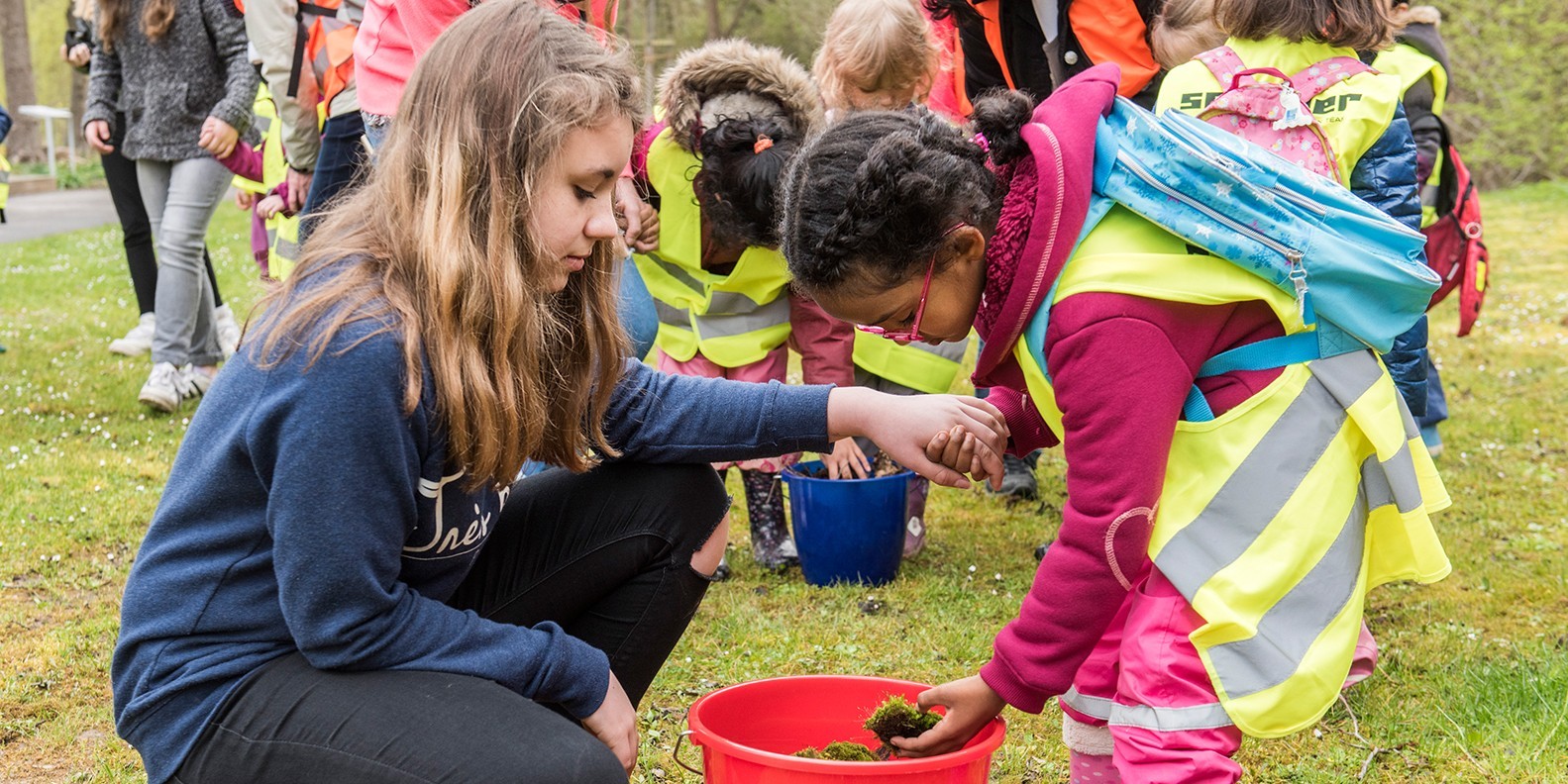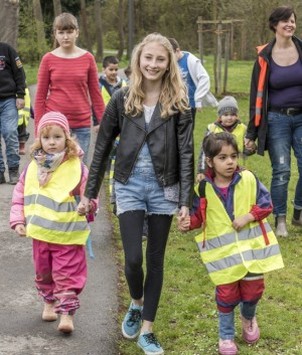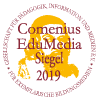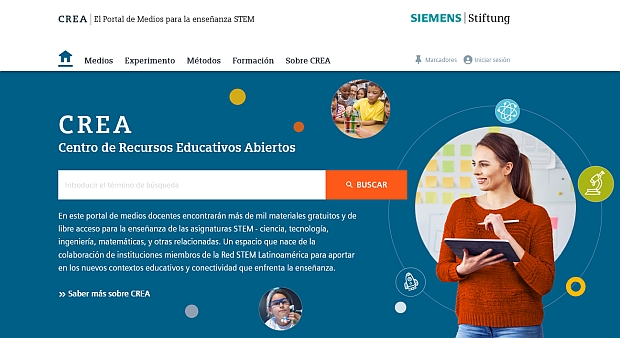
Service-Learning as a teaching method
Service-Learning as a holistic approach
Service-Learning – Learning through Civic Engagement is a teaching and learning model in which students take what they learn in the classroom and apply it directly to hands-on projects in their neighborhood or community. This shows them the relevance of their STEM learning for day-to-day life and society. A follow-up classroom session lets the students talk about their experience and put it all in context. This allows them to draw conclusions for how they would like to lead their own lives and actively cultivate a system of values. Service-Learning is woven into the classroom curriculum and day-to-day school experience. It is appropriate for all types of schools, age groups, and subjects (Seifert/Zentner/Nagy 2012).
Method Media Real-life examples SourcesWhat is Service-Learning?
Learn within three minutes what Service-Learning is all about and how you can use the teaching method in your STEM lessons.
How does Service-Learning help students learn?
A strictly theoretical study of science and technology in school is not adequate to assess the societal impact of such issues as climate change or the digitalization. STEM education should go further, allowing schoolchildren to comprehend the interaction of science, technology, and society. They should learn to recognize, reflect upon, and critically evaluate interrelationships. By getting involved in local projects, students have the opportunity to apply in practice what they have learned in their STEM classes. This personal involvement helps reinforce that knowledge and gives shape to theoretical moral concepts.
The projects also expose students to other life experiences and perspectives outside the school. By working with preschoolers, seniors, or refugees, they gain an entirely different perspective on their own actions. But above all, they see that they can make an impact with their skills and talents when they take on responsibility in their environment.
What are the learning objectives of Service-Learning?
Service-Learning, by combining civic engagement and classroom learning, focuses on two core objectives: changing teaching and learning culture, and strengthening democracy and civil society. In their projects, students explore methods for applying their classroom knowledge to practice. But they also train key social and personal skills. Through practical application and reflection, they develop a system of values. A key factor is civic engagement for the common good and contact with people from different groups in society. Values such as responsibility, environmental awareness, and solidarity become concrete and can be experienced personally.
Background in learning theory
Service-Learning pursues two core objectives:
- Strengthening democracy and civil society
- Transforming the classroom experience and learning culture
These core objectives reflect two theoretical approaches that inspired Service-Learning and derive in part from the ideas of educator and philosopher John Dewey (1859–1952).
What is meant by democracy as a form of life?
Dewey sees democracy as more than a model for governments and nation states. His view is that democracy is also a form of coexistence that relies on participation, mutual acceptance of responsibility, and commonly practiced democratic values. An important mission of education and training is therefore to enable children and young people to participate in community life with their own competencies. Young people should acquire knowledge and skills that will allow them to work alongside others in shaping and improving democratic civil society (Oelkers 2000).
How do we learn through experience?
In addition to Dewey’s concept of democracy, his ideas on learning theory also influenced the development of Service-Learning. According to Dewey, the acts of doing and reflecting are part of the cognition process (Oelkers 2000). The interplay of action and reflection creates a cycle that triggers a continuous series of new learning processes. Dewey emphasized that the best way for people to acquire knowledge and skills is in real-life situations that confront them with unresolved questions and problems. This challenges students and motivates them to acquire the knowledge and skills needed to solve the problem.
Quality of implementation
A critical factor in the success of Service-Learning is the quality of the implementation. The skills that the students are supposed to acquire through the project should be clearly defined in advance. Only when these skills are directly related to their civic engagement can the children associate these skills with their work on the project. This reflection is critical for the success of the learning (Ammon, Furco, Chi & Middaugh 2002).
Quality Standards according to Seifert/Zentner/Nagy (2012)
Effects of Service-Learning
Service-Learning has an indisputably positive effect on learning in schools, the development of personal attributes, and attitudes toward civil society and the community. It also has a demonstrated ability to increase children’s enthusiasm for school and motivation to learn. And finally, it can strengthen students’ problem-solving skills and contribute to a deeper understanding of educational content (see summary in Billig 2004, RMC Research Cooperation 2007).
Encourage values in MINT education
The use of Service-Learning in STEM subjects can be especially effective in highlighting their real-life social relevance. More students develop an enthusiasm for science and technology when they can see its relevance in everyday life. This enhances the attractiveness of the STEM subjects. Service-Learning can also help promote the following values.
- Sustainability: giving consideration to economic, environmental, and social development for all generations
- Taking responsibility: accepting the consequences for one’s own decisions and actions
- Environmental awareness: caring for the environment and adapting one’s actions accordingly
- Solidarity: building a society based on cohesion and mutual support
- Social justice: advocating for fair distribution of the goods of society
Development of democratic skills
Students who have taken part in a Service-Learning project show a higher sense of democratic and social responsibility (see summary in Billig 2004; RMC Research Corporation 2007). They exhibit greater interest in social challenges, are more acutely aware of them, and are more likely to be willing and able to help make change happen themselves. This is often accompanied by greater identification with their own surroundings, but also with democratic values and attitudes. The motivation to stay involved is also demonstrably higher (see also: BürgerStiftung Hamburg 2011).
Here, too, the positive effects on learning are achieved only if the quality and implementation of Service-Learning is high and the educational focus is right. An example: Morgan und Streb (2001) were able to show that the positive impact on the democratic attitudes of students depends on whether they are actively involved in planning and shaping their engagement. In other words, by going through the democratic processes on their own with the opportunity to make decisions for themselves and take on responsible, challenging tasks.
Personality development of children and adolescents
Past experience shows that Service-Learning has primarily positive effects on the personality development and social skills of children and adolescents (see summary in Billig 2004; RMC Research Corporation 2007). This includes
- Sense of empowerment: building trust in their own strength and potential (see also: BürgerStiftung Hamburg 2011)
- Sense of self-worth
- Communication and team skills
- Powers of empathy
- Moral development
- Professionally relevant skills – such as the ability to plan or communicate in a manner appropriate to the given situation
- Orientation and motivation relating to the subsequent choice of a career (Furco 2002).
About the author

Franziska Nagy has been working on topics related to “Service-Learning – Learning through Civic Engagement” at schools since 2010. This work is aimed at providing all children with good educational experiences and access to civic engagement as well as improving their democratic skills. Ms. Nagy initially worked as a project team member at the Freudenberg Foundation. Since 2017, she has been head of the Politics, Science, and Cooperation areas at the Foundation for Learning through Civic Engagement, a spin-off of the Freudenberg Foundation. Since 2014, she is responsible for “Service Learning in STEM subjects,” a collaboration project with Siemens Stiftung that focuses on distributing developed materials throughout Germany, such as web-based training for teachers.
Media for the application of the method
The handout for “Service-Learning in STEM subjects” offers numerous real-life examples on 48 pages. As a suggestion for developing and planning their first service-learning projects, it is aimed at teachers from primary and secondary schools. The handout is available in English, Spanish and German.
Real-life example
Water days for daycare-kids

© Siemens Stiftung/Freudenberg Stiftung
A middle school set out to rethink how it taught physics, chemistry, and biology: The idea was that the students, most of them from at-risk environments, would have the opportunity to experience the application of scientific content for themselves early on. The subject of “water” was on the lesson plan for sixth grade, and the teacher had already contacted a local daycare center. The students talked in class about what they could do for the daycare center and decided to sponsor “water afternoons,” since their research showed that the daycare centers were already teaching basic science. In the classroom, the sixth-graders acquired knowledge about water and meticulously prepared their engagement. The students spent several mornings with the little ones, conducting experiments and leading an interactive walk along a creek to give them a fun way to learn about water. Their engagement motivated them to plan for the construction of a sustainable water playground for the daycare center during the next school year. The students learned that water is an important resource, so they wanted to build and design the playground accordingly – using a rainwater system, for example.
At a glance:
- Service-Learning as a half-year project for sixth-graders at a middle school
- Educational objective: Enabling self-efficacy and make students feel more empowered
- Teaching content:
Physics, chemistry, biology --> Biosphere and basis of life: water - Values in focus:
Sustainability --> Using water consciously
Sources
Ammon, M. S., Furco, A., Chi, B. & Middaugh, E. (2002): Servicelearning in California: A profile of the Cal Serve service-learning partnerships (1997-2000). Berkeley, CA: Service-Learning Research and Development Center, University of California.
Billig, S. H. (2004): Heads, hearts, and hands: The research on k–12 service-learning. In National Youth Leadership Council (Hrsg.), Growing to Greatness 2004 (S. 12-25). Saint Paul, MN: National Youth Leadership Council (NYLC).
BürgerStiftung Hamburg (2011): ['You:sful] – Lernen durch Engagement. Evaluationsergebnisse 2009-2011. Available at: https://www.buergerstiftung-hamburg.de/fileadmin/user_upload/Projektfoerderung/Projekte/Yousful/Yousful_Evaluation_2009_11_Web.pdf [05.05.2012].
Furco, A. (2002): Is service-learning really better than community service? A study of high school service program outcomes. In A. Furco & S. H. Billig (Hrsg.), Service-learning: The essence of the pedagogy (S. 23-50). Greenwich, CT: Information Age.
Morgan, W. & Streb, M. (2001): Building citizenship: How student voice in service-learning develops civic values. Social Science Quarterly, 82(1), 154-169.
Oelkers, J. (Hrsg.). (2000): Demokratie und Erziehung. Eine Einleitung in die philosophische Pädagogik. Weinheim: Beltz.
RMC Research Corporation. (2007). Impacts of service-learning on participating K-12 students. Available at: • https://leduccenter.files.wordpress.com/2015/02/sl_impacts-on-k12_students.pdf [05.05.2012].
Seifert, A. (2011): Resilienzförderung an der Schule: Eine Studie zu Service-Learning mit Schülern aus Risikolagen. Wiesbaden: VS-Verlag.
Seifert, A. & Zentner, S. (2010): Service-Learning – Lernen durch Engagement: Methode, Qualität, Beispiele und ausgewählte Schwerpunkte. Eine Publikation des Netzwerks Lernen durch Engagement. Weinheim: Freudenberg Stiftung. Available at: https://www.schulentwicklung.nrw.de/unterstuetzungsportal/rr_datei_download.php?dateiid=1666 [05.05.2012]
Seifert, A. & Zentner, S. & Nagy, F. (2012). Praxisbuch Service-Learning – „Lernen durch Engagement an Schulen“. Weinheim/Basel: Beltz.
Sliwka, A. (2002): Service Learning an Schulen in Deutschland. Bericht über den Pilotversuch „Verantwortung lernen – Service Learning“ der Freudenberg Stiftung. Weinheim: Freudenberg Stiftung.
Sliwka, A. (2004): Service Learning: Verantwortung lernen in Schule und Gemeinde. In W. Edelstein & P. Fauser (Hrsg.), Beiträge zur Demokratiepädagogik. Eine Schriftenreihe des BLKProgramms „Demokratie lernen & leben“. Available at: https://www.pedocs.de/volltexte/2008/258/pdf/Sliwka.pdf [05.05.2012].
Sliwka, A. (2008): Bürgerbildung: Demokratie beginnt in der Schule. Weinheim/Basel: Beltz.
Sliwka, A. & Frank, S. (2004): Service Learning: Verantwortung lernen in Schule und Gemeinde. Weinheim/Basel: Beltz.


